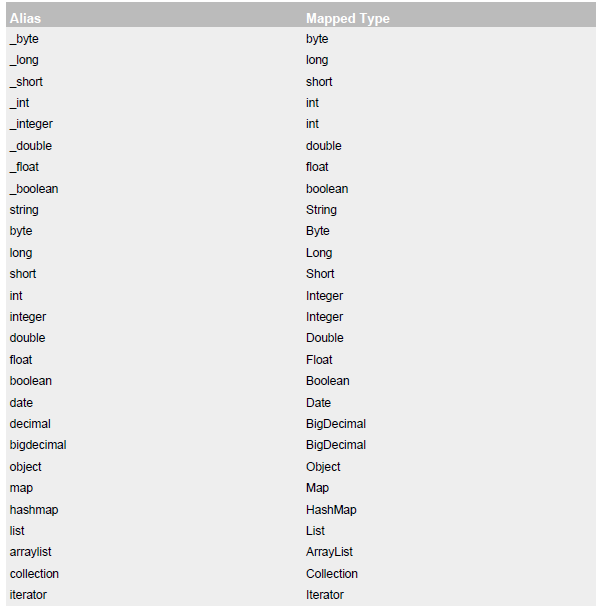Mybatis中collection和association的使用區別
阿新 • • 發佈:2018-12-01
ring striped ram ati column font -a str result
1. 關聯-association
2. 集合-collection
比如同時有User.java和Card.java兩個類
User.java如下:
public class User{
private Card card_one;
private List<Card> card_many;
}
在映射card_one屬性時用association標簽, 映射card_many時用collection標簽.
所以association是用於一對一和多對一,而collection是用於一對多的關系
下面就用一些例子解釋下吧
association-一對一
人和身份證的關系
下面是pojo
| 1 2 3 4 5 | public class Card implements Serializable{ private Integer id; private String code; //省略set和get方法. } |
| 1 2 3 4 5 6 7 8 9 |
public class Person implements Serializable{
private Integer id;
private String name;
private String sex;
private Integer age; |
下面是mapper和實現的接口
| 1 2 3 4 5 6 7 | package com.glj.mapper; import com.glj.poji.Card; public interface CardMapper { Card selectCardById(Integer id); } |
| 1 2 3 4 5 6 7 8 9 |
<?xml version="1.0" encoding="UTF-8"?> |
| 1 2 3 4 5 6 7 | package com.glj.mapper; import com.glj.poji.Person; public interface PersonMapper { Person selectPersonById(Integer id); } |
| 1 2 3 4 5 6 7 8 9 10 11 12 13 14 15 16 17 18 19 | <?xml version="1.0" encoding="UTF-8"?> <!DOCTYPE mapper PUBLIC "-//mybatis.org//DTD Mapper 3.0//EN" "http://mybatis.org/dtd/mybatis-3-mapper.dtd"> <mapper namespace="com.glj.mapper.PersonMapper"> <resultMap type="com.glj.poji.Person" id="personMapper"> <id property="id" column="id"/> <result property="name" column="name"/> <result property="sex" column="sex"/> <result property="age" column="age"/> <association property="card" column="card_id" select="com.glj.mapper.CardMapper.selectCardById" javaType="com.glj.poji.Card"> </association> </resultMap> <select id="selectPersonById" parameterType="int" resultMap="personMapper"> select * from tb_person where id = #{id} </select> </mapper> |
PersonMapper.xml 還使用association的分步查詢。
同理多對一,也是一樣
只要那個pojo出現private Card card_one;
即使用association
collection 一對多和association的多對一關系
學生和班級的一對多的例子
pojo類
| 1 2 3 4 5 6 7 8 9 10 11 12 13 | package com.glj.pojo; import java.io.Serializable; import java.util.List; public class Clazz implements Serializable{ private Integer id; private String code; private String name; //班級與學生是一對多的關系 private List<Student> students; //省略set/get方法 } |
| 1 2 3 4 5 6 7 8 9 10 11 12 13 | package com.glj.pojo; import java.io.Serializable; public class Student implements Serializable { private Integer id; private String name; private String sex; private Integer age; //學生與班級是多對一的關系 private Clazz clazz; //省略set/get方法 } |
| 1 2 3 4 5 6 7 8 9 10 11 12 13 14 15 16 17 18 19 20 21 22 23 | <?xml version="1.0" encoding="UTF-8"?> <!DOCTYPE mapper PUBLIC "-//mybatis.org//DTD Mapper 3.0//EN" "http://mybatis.org/dtd/mybatis-3-mapper.dtd"> <mapper namespace="com.glj.mapper.ClazzMapper"> <select id="selectClazzById" parameterType="int" resultMap="clazzResultMap"> select * from tb_clazz where id = #{id} </select> <resultMap type="com.glj.pojo.Clazz" id="clazzResultMap"> <id property="id" column="id"/> <result property="code" column="code"/> <result property="name" column="name"/> <!-- property: 指的是集合屬性的值, ofType:指的是集合中元素的類型 --> <collection property="students" ofType="com.glj.pojo.Student" column="id" javaType="ArrayList" fetchType="lazy" select="com.glj.mapper.StudentMapper.selectStudentByClazzId"> <id property="id" column="id"/> <result property="name" column="name"/> <result property="sex" column="sex"/> <result property="age" column="age"/> </collection> </resultMap> </mapper> |
| 1 2 3 4 5 6 7 | package com.glj.mapper; import com.glj.pojo.Clazz; public interface ClazzMapper { Clazz selectClazzById(Integer id); } |
ClazzMapper使用到了集合-collection 即為一對多,一個班級面對多個學生
| 1 2 3 4 5 6 7 8 9 10 11 12 13 14 15 16 17 18 19 20 21 22 23 | <?xml version="1.0" encoding="UTF-8"?> <!DOCTYPE mapper PUBLIC "-//mybatis.org//DTD Mapper 3.0//EN" "http://mybatis.org/dtd/mybatis-3-mapper.dtd"> <mapper namespace="com.glj.mapper.StudentMapper"> <select id="selectStudentById" parameterType="int" resultMap="studentResultMap"> select * from tb_clazz c,tb_student s where c.id = s.id and s.id = #{id} </select> <select id="selectStudentByClazzId" parameterType="int" resultMap="studentResultMap"> select * from tb_student where clazz_id = #{id} </select> <resultMap type="com.glj.pojo.Student" id="studentResultMap"> <id property="id" column="id"/> <result property="name" column="name"/> <result property="sex" column="sex"/> <result property="age" column="age"/> <association property="clazz" javaType="com.glj.pojo.Clazz"> <id property="id" column="id"/> <result property="code" column="code"/> <result property="name" column="name"/> </association> </resultMap> </mapper> |
| 1 2 3 4 5 6 7 | package com.glj.mapper; import com.glj.pojo.Student; public interface StudentMapper { Student selectStudentById(Integer id); } |
StudentMapper則是與班級為多對一關系,所以使用了關聯-association
嗯,希望我以後又不記得二者的關系時,能感謝現在總結的自己
附上一張mybatis的類型別名圖

Mybatis中collection和association的使用區別
